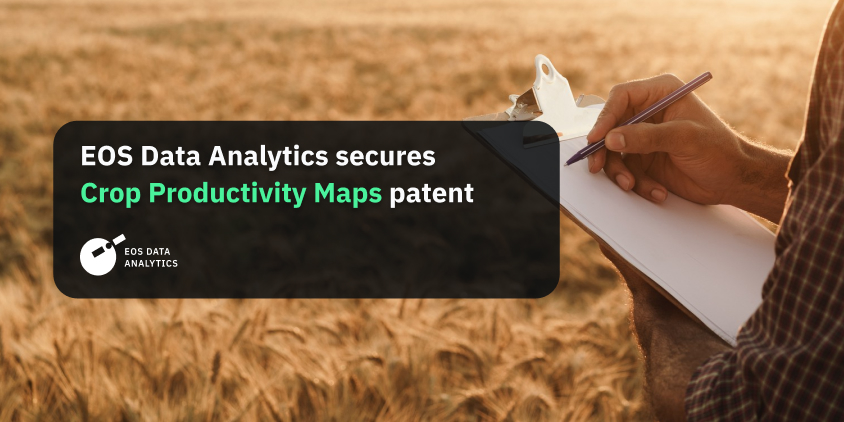
EOSDA Secures Crop Productivity Maps Patent
EOS Data Analytics, a global provider of AI-powered satellite imagery analytics founded by Dr. Max Polyakov, has obtained a United States patent for an algorithm built at the intersection of mathematics, geospatial analysis, agronomy, and computer science. Users can already try it out in EOSDA Crop Monitoring, a web-based solution for smart agriculture.
The patent #11,663,753 B1 issued by The United States Patent and Trademark Office on May 30th, 2023 secures a method for generating field productivity maps.
Preserving sustainable crop production while ensuring food security requires the availability of precision agritech tools across different mediums. Fragmentation, lack of standard data architecture, and cross-platform interoperability might limit the ability of growers to progress toward these goals . That is why tech businesses are increasingly expanding their offerings in software and hardware infrastructures that enable less resource-intensive growth.
The productivity maps proposed by EOS Data Analytics provide a visualized estimation of vegetation trends in a certain geographical area over a given timeframe. The purpose of such maps is to remotely assess the level of soil productivity that a certain field zone has (based on vegetation patterns). The backend algorithm works in a web-based environment and takes up to one minute to deliver the output productivity map. The server infrastructure, as well as the software architecture and mathematical logic of the algorithm, are secured by the patent.
We are committed to meeting the evolving needs of agricultural businesses and individual growers. Our productivity maps algorithm executes complex computations in a matter of seconds, regardless of the endpoint device’s technical specifications. Basically, we can deliver satellite-powered analytics to anything that connects to any type of network, whether it be an old computer with an Ethernet cable in the office, a smartphone on the go, or next-gen farming machinery with its own differentiated seeding software.
For every individual request, the algorithm chooses the most relevant satellite imagery, then automatically gets rid of the noise (like clouds), runs the pixels through vegetation indexing algorithms, clusters them according to values rating, and finally, puts them on a map.
Part of the innovation is that we patented not only the scientific backbone but also the technical architecture mode. We’ve noticed that current agtech works in silos. It lacks a viable infrastructure while most software solutions are cryptic and difficult to put to practice, not to mention the inability to measure ROI. Our algorithm is boiled down to an elegant formula that works across multiple interfaces and embraces the core principle of field productivity. It is applicable to local patterns of place and time and lays a solid foundation for so many opportunities in agriculture.
In the forthcoming iterations of EOSDA Crop Monitoring, the patented technology will be enhanced with new features that will help farmers make data-driven decisions, like the ability to add up different analytical layers on top of one another for an even more precise understanding of the field’s unique characteristics. Also, since the patented algorithm is quite flexible, it can be used as a backbone for custom projects in the event of adding more datasets to increase accuracy.
This data will be available in a cross-platform format, effortlessly connecting different software & hardware mediums, which will reduce human error and elevate agricultural practices to a whole new level. For example, upon uploading the productivity map, farmers will be able to perform precise soil sampling and apply variable-rate sowing and potassium-phosphorus fertilizer dispersion. Improving precision agriculture practices this way might lead to an increase in profitability, environmental risk mitigation, and social responsibility enhancement.
About the author:
Rim Elijah holds a double degree in business administration and political science from Stockholm University. As a VP of Sales at EOSDA, she oversees all aspects of business model development and implementation and the growth of the company’s global coverage. She has successfully established a number of strategic partnerships with an emphasis on sustainable solutions in Africa and Asia.
Recent articles

Analyze 2025 & Plan Your Best Year Yet: LandViewer Christmas Offer
It’s the most wonderful time of the year! The Christmas holidays are here, and so is your chance to analyze 2025 and plan a prosperous 2026 with more affordable Pro plans in LandViewer.

EOSDA Models Climate Change Impact On Sugarcane Yields
EOSDA modeled future temperature, rainfall, and other climate impacts on Veracruz sugarcane. The results help growers plan long-term adaptation strategies, including timing, varieties, and irrigation.

EOSDA LandViewer Black Friday Sale: Exclusive Offers & Giveaway
This Black Friday, LandViewer offers new users the chance to save on monthly plans, get extra months with yearly subscriptions, and participate in a free annual plan giveaway.